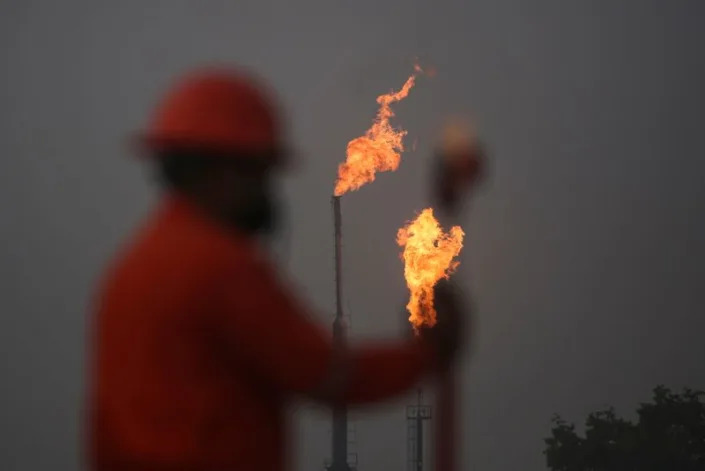Homeland Security Admits It Tried to Manufacture Fake Terrorists for Trump
Dell Cameron
Sat, November 5, 2022

Photo: Associated Press (AP)
The Department of Homeland Security launched a failed operation that ensnared hundreds, if not thousands, of U.S. protesters in what new documents show was as a sweeping, power-hungry effort before the 2020 election to bolster President Donald Trump’s spurious claims about a “terrorist organization” he accused his Democratic rivals of supporting.
An internal investigative report, made public this month by Sen. Ron Wyden, a Democrat of Oregon, details the findings of DHS lawyers concerning a previously undisclosed effort by Trump’s acting secretary of homeland security, Chad Wolf, to amass secret dossiers on Americans in Portland attending anti-racism protests in summer 2020 sparked by the police murder of Minneapolis father George Floyd.
The report describes attempts by top officials to link protesters to an imaginary terrorist plot in an apparent effort to boost Trump’s reelection odds, raising concerns now about the ability of a sitting president to co-opt billions of dollars’ worth of domestic intelligence assets for their own political gain. DHS analysts recounted orders to generate evidence of financial ties between protesters in custody; an effort that, had they not failed, would have seemingly served to legitimize President Trump’s false claims about “Antifa,” an “organization” that even his most loyal intelligence officers failed to drum up proof ever existed.
“Did not find any evidence that assertion was true”
The DHS report offers a full accounting of the intelligence activities happening behind the scenes of officers’ protest containment; “twisted efforts,” Wyden said, of Trump administration officials promoting “baseless conspiracy theories” to manufacture of a domestic terrorist threat for the president’s “political gain.” The report describes the dossiers generated by DHS as having detailed the past whereabouts and the “friends and followers of the subjects, as well as their interests” — up to and including “First Amendment speech activity.” Intelligence analysts had internally raised concerns about the decision to accuse anyone caught in the streets by default of being an “anarchist extremist” specifically because “sufficient facts” were never found “to support such a characterization.”
One field operations analyst told interviewers that the charts were hastily “thrown together,” adding they “didn’t even know why some of the people were arrested.” In some cases, it was unclear whether the arrests were made by police or by one of the several federal agencies on the ground. The analysts were never provided arrest affidavits or paperwork, a witness told investigators, adding that they “just worked off the assumption that everyone on the list was arrested.” Lawyers who reviewed 43 of the dossiers found it “concerning,” the report says, that 13 of them stemmed from “nonviolent crimes.” These included trespassing, though it was unclear to analysts and investigators whether the cases had “any relationship to federal property,” the report says.
A footnote in the report states that “at least one witness” told investigators that dossiers had been requested on people who were “not arrested” but merely accused of threats. Another, citing emails exchanged between top intelligence officials, states dossiers were created “on persons arrested having nothing to do with homeland security or threats to officers.”
Questioned by investigators, the agency’s chief intelligence officer acknowledged fielding requests by Wolf and his acting deputy, Ken Cuccinelli, to create dossiers “against everyone participating in the Portland protest,” regardless of whether they’d been accused of any crime, the report says. That officer, Brian Murphy, then head of the agency’s Office of Intelligence and Analysis (I&A), told interviewers that he’d rejected the idea, informing his bosses that he could only “look at people who were arrested,” and adding that it was something his office had done “thousands” of times before.
The DHS report, finalized more than a year ago, includes descriptions of orders handed down to “senior leadership” instructing them to broadly apply the label “violent antifa anarchists inspired” to Portland protesters unless they had intel showing “something different.”
Once the dossiers were received by the agency’s emerging threat center, it became clear that DHS had no real way to tie the protesters to any terrorist activities, neither at home nor abroad. Efforts to drum up evidence to support the administration’s claim that a “larger network was directing or financing” the protesters — a task assigned to another unit, known as the Homeland Identities, Targeting and Exploitation Center, diverted away from its usual work of analyzing national security threats — “did not find any evidence that assertion was true,” the report says.
A Trumped-up Threat, a Trumped-up Homeland Security Department
Fears of political toadies occupying key intelligence roles had been aired publicly by former intelligence community members during the Trump administration’s early years, but their concerns were all but ignored by Senate Republicans during confirmation hearings that would ultimately inflict serious reputational damage on a number of agencies that, for their own survival, had long avoided partisan leanings.
The report is based on interviews with approximately 80 employees conducted by attorneys drawn from various agency components, including U.S. Customs and Border Protection and the U.S. Coast Guard. The investigation began in response to leaks of internal DHS emails in July 2020 that prompted questions from lawmakers about potential intelligence abuses, including the monitoring of journalists’ activities online and the liberal application of terrorism-related language to describe Americans engaged in protest.
I&A is one of the nation’s 17 intelligence community members overseen by the nation’s “top spy,” the director of national intelligence, whose office drafts daily top-secret briefings for the president. The directorship was held throughout the protests by John Ratcliffe, a Republican of Texas and renowned Trump loyalist, whose nomination to the post was withdrawn initially in 2019 over qualifications concerns raised by lawmakers and career intelligence officials.
The dossiers, known as Operational Background Reports, or OBRs, are known colloquially within the agency as “baseball cards,” the report says. The task of creating them was handed, “with little to no guidance on execution,” to the agency’s Current and Emerging Threats Center, an analysis unit whose “actionable intelligence” is distributed widely throughout the government. According to the report, the dossiers would’ve been shared with, among others, the agency’s Field Operations Division, which works closely with House and Senate committee staffers, and the Federal Protection Service, whose core mission is securing some 9,000 federal facilities across the country. The extent to which entities outside the federal government were meant to be involved is unclear; however, the report indicates that DHS state and local partners, which would naturally include law enforcement, but also potentially organizations like National Governors Association, could have also been in the loop.
Funded to the tune of $1.5 billion, the Federal Protective Service (FPS) is comprised of thousands of security officers drawn from private contractors such as Triple Canopy, a firm merged in 2014 with another contractor called Academi, previously known as Blackwater. Its staff notoriously included elite warfighters recruited from among the Navy SEALS, the Army Rangers, and the Marines expeditionary force MARSOC.
Activated to engage protesters targeting federal buildings in Portland — including the well-vandalized Hatfield Federal Courthouse — FPS personnel were eventually joined by officers hailing from across the federal government, including some on loan by the U.S. Marshals Service tactical unit normally tasked with making the arrests of the nation’s most violent fugitives. They converged for a mission dubbed “Operation Diligent Valor,” authorized under Executive Order 13933, purportedly to apprehend “anarchists and left-wing extremists” who’d been driven by Floyd’s murder to target U.S. monuments commemorating slave owners and Confederate traitors — dangerous individuals, Trump said, advancing a “fringe ideology” painting the U.S. government as “fundamentally unjust.”
Floyd’s death at the hands of Minneapolis police officer Derek Chauvin, convicted of murder and sentenced to 22 and a half years in prison in 2021, sparked more than 100 days of continuous marches in Portland. Sporadic protests continued well into the next spring, frequently marked by nightly standoffs between protesters toting bottles, fruit, and fireworks and riot-control squads armed with nightsticks, pepperspray, and “kinetic impact munitions” designed to irritate, disorient, and compel compliance through pain.
Police would eventually rack up an unprecedented 6,000 documented use-of-force cases against the demonstrators, who in turn reportedly inflicted more than $2.3 million in damage to federal buildings alone. Police ran off legal observers and physically beat journalist who suffered injuries at the hands of federal agents armed with crowd control weapons as well. In response to the bad press, Justice Department lawyers filed a successful motion in court giving police the power to force reporters off the streets.
Reports began surfacing, meanwhile, of protesters being abducted near demonstrations by men jumping out of unmarked vans in military fatigues. After widely circulated footage confirmed the accounts, DHS acknowledged the abductions, as well as the fact that agents had taken intentional steps to ensure their identities remained secret.
Analysts would feed protesters’ names into an array of databases, including LexisNexis, a tool used by Immigration and Customs Enforcement agents to hunt undocumented immigrants. Another tool, referred to as “Tangles” — a likely reference to the now-defunct Facebook app CrowdTangle — was used to “[compile] information from the subject’s available social media profiles.
The report also states that dossiers were requested on multiple journalists, including Benjamin Wittes, editor-in-chief of Lawfare.
Wittes was targeted for publishing unclassified DHS materials, including the initial leak that set off the investigation. Wittes had coauthored an article at Lawfare with Steve Vladeck, a University of Texas law professor, in July 2020, which included leaked guidance — known as a “job aid” — disclosing DHS plans to act on Trump’s executive order. The document, Lawfare reported, implicated “at least parts of the intelligence community” in the “monitoring and collecting information on some protest activities.” Later leaks obtained by the New York Times included a DHS memo that, among other things, summarized tweets that had been published by Wittes.
One tweet, published on July 26 — a week after Lawfare published the guidance document — included a leaked email by DHS’s acting chief intelligence officer, relaying orders to begin referring to all violence in Portland as the work of “Antifa.”
As the summer nights grew longer and the 2020 elections near, the media spent less time focused on the cause of the demonstrations — the suffocation of a Black father of five by a white Minneapolis police officer who was outwardly unmoved by Floyd’s desperate pleas for air, or the heartrending cries for his mother. Headlines shifted instead, as if on cue, to focus on the narrative crafted by the president’s flailing reelection campaign; a pre-packed delusion designed to strike fear in voters’ imaginations and tether Democrats to a fictitious terrorist threat.
Nothing could dissuade Trump from continuing to propagate the claims, which his supporters — most to this day — continue to blindly believe. “In my book it’s virtually a part of their campaign, Antifa,” Trump said in the final months before the election. “The Democrats act like, gee, I don’t know exactly what that is.”
Trump’s highest ranking intelligence crony, John Ratcliffe, meanwhile, would go on to play the only card left with a little help from Sen. Lindsey Graham, the Republican chairman of the Senate Judiciary Committee.
Shocking and alarming career intelligence officials, Graham posted a letter online ahead of the election’s final debate. It contained a batch of Russian disinformation that a Republican-led committee had disregarded as bogus four years earlier. Apparently, it focused on the only Democratic left on whom they could find any material with which to smear: Hillary Clinton, who had no election to lose.
Gizmodo







